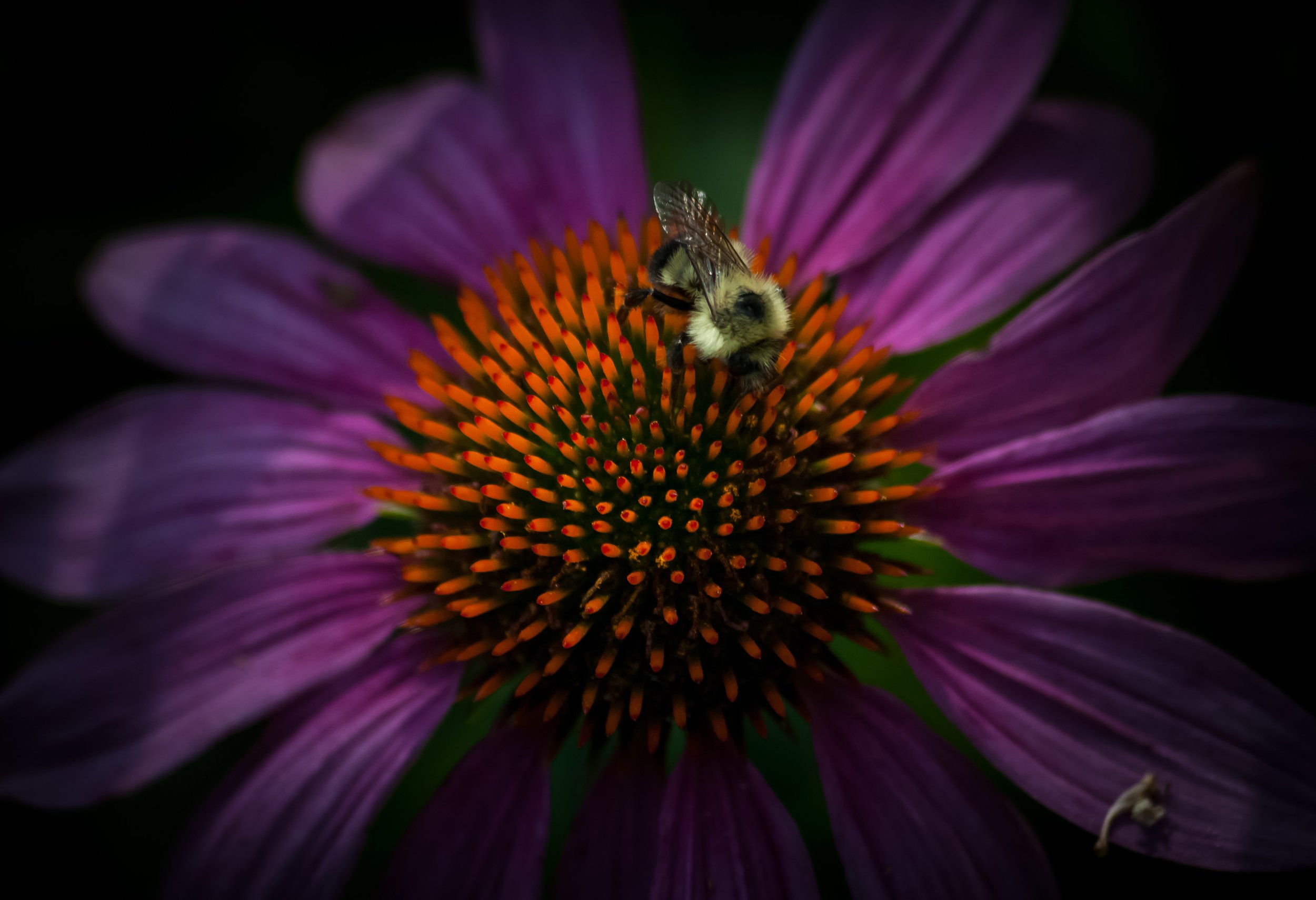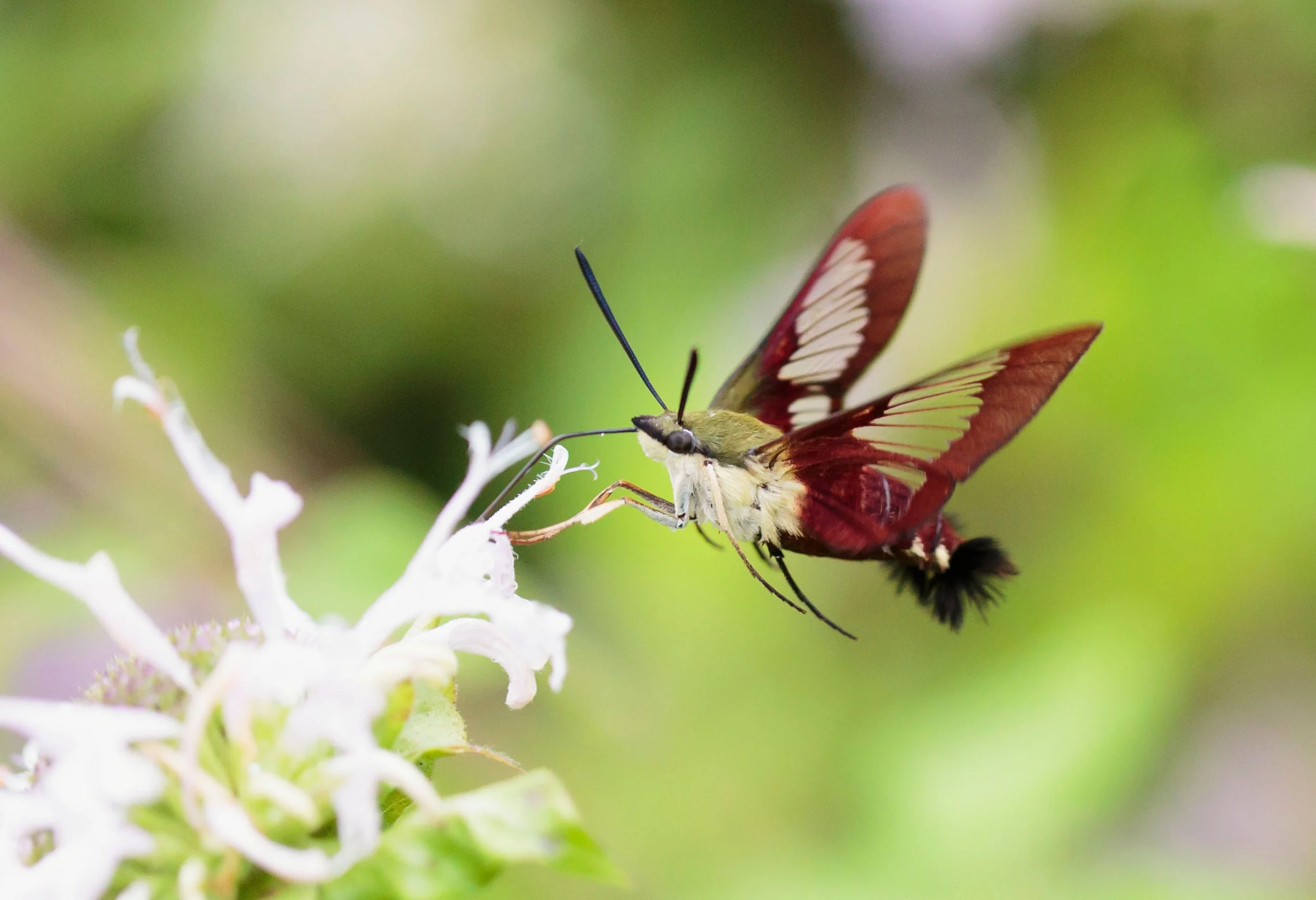Planting for Pollinators in the Chicago Area
A bee feeding on Echinacea. Photo by Shadowmeld Photography - CC BY-SA 4.0.
While monarchs and milkweed get a lot of attention (migrating to and from Mexico every year is very impressive), there are thousands of other native pollinators in the Chicago area just waiting for you to plant their favorite flowers.
At least 75% of the world’s flowering plants need help from pollinators to reproduce. While feeding at flowers, our native butterflies, moths, flies, beetles, wasps, bees and even birds transfer pollen and help plants produce the next generation of seeds.
A note on bees, wasps and flies: You may be thinking… “Bees sting! Flies are gross! I don’t want them near me!” Many bees and wasps can sting—but they generally don’t unless you handle them or disturb a nesting site (and many of our 4,000 species of North American bees don’t sting at all). When it comes to flies, we aren’t talking about nonnative houseflies. Native flies are interested in your flowers, not you or your house, and many of them do a pretty convincing bee impression.
Pollinators are critical for human food production and help maintain clean air and water—without them we’d be in a lot of trouble. And unfortunately, they’re in a lot of trouble, which is why it has never been more important to give them space to thrive in our yards, balconies and rooftops.
Planning a garden for native pollinators has an added benefit for humans: flowers blooming in every season! While our focus here is suggesting blooms that will appeal to pollinators and people, remember that pollinators need more than just beautiful flowers to survive. Including native grasses and sedges (and trees and shrubs when possible) helps provide a well-rounded garden with shelter, nesting sites and additional food for all phases of their development.
Visit Christy Webber Farm & Garden’s Native Plant department to get your pollinator garden buzzing with life!
Wild geranium (Geranium maculatum).
Spring
Spring can be a lean time for emerging pollinators. In addition to planting native plants with spring bloom times in your garden, consider letting dandelions and clover bloom in your lawn to provide additional food sources during this critical period.
Golden Alexanders (Zizia aurea) and heartleaf golden Alexanders (Zizia aptera) thrive in full sun, but can tolerate some shade. Each produces showy clusters of small yellow flowers that bloom from spring to early summer, attracting a long list of native bees and wasps. As members of the carrot family, these plants also serve as hosts for caterpillars of black swallowtail butterflies.
Wild geranium (Geranium maculatum) provides beautiful, long-blooming pink flowers and deeply-lobed leaves that turn a stunning red in fall. Best planted in light shade to part sun, the flowers attract a variety of bees, including bumblebees, mason bees, and cuckoo bees, along with butterflies and skippers. Caterpillars of several moth species use wild geranium as a host plant.
Prairie willow (Salix humilis) flowers appear in thin, rounded clusters (called catkins) before leaves develop in the spring. This interesting shrub is a pollinator powerhouse, attracting a large number of small bees and flies. It serves as a host for the caterpillars of butterflies and moths, and larval stages of other insects. Willow thickets also provide ideal nesting sites for a variety of birds.
Other great options we carry: foxglove beardtongue (Penstemon digitalis), Jacob's ladder (Polemonium reptans), Ohio spiderwort (Tradescantia ohioensis), prairie smoke (Geum triflorum), Virginia bluebells (Mertensia virginica), Virginia waterleaf (Hydrophyllum virginianum), white trillium (Trillium grandiflorum), wild columbine (Aquilegia canadensis).
Hummingbird clearwing moth feeding on Monarda.
Summer
Summer provides a lot of options for gardeners and native pollinators. Focus on choosing flowers with different shapes and sizes—a butterfly with a long tongue has different needs than a short-tongued bee.
Wild bergamot (Monarda fistulosa) and spotted bee-balm (Monarda punctata) both have showy and unique flowers that feed a variety of bees, butterflies and moths (like the hummingbird clearwing moth above). Both thrive in full sun and can tolerate dry conditions.
Purple coneflower (Echinacea purpurea) and pale purple coneflower (Echinacea pallida) are classic prairie plants and magnets for bees and butterflies. Plant these in full sun (purple coneflower can tolerate some shade) and expect to see a steady stream of bumblebees and butterflies (including monarchs, swallowtails and fritillaries). A variety of butterfly and moth caterpillars feed on their leaves and flowers.
Common mountain mint (Pycnanthemum virginianum) packs up to 50 small white flowers into each stem’s flowerhead and blooms for nearly a month in mid-summer. This shorter (under three feet), bushy plant attracts beetles, butterflies, flies, bees and wasps in full or part sun.
Other great options we carry: butterfly milkweed, common milkweed, prairie milkweed, rose milkweed, and whorled milkweed (Asclepias spp.); purple prairie clover and white prairie clover (Dalea spp.); marsh blazingstar, prairie blazingstar, and rough blazingstar (Liatris spp.); black-eyed Susan, brown-eyed Susan, cutleaf coneflower, showy black-eyed Susan, sweet black-eyed Susan (Rudbeckia spp.); royal catchfly and starry campion (Silene spp.); compass plant, cup plant, prairie dock, and rosinweed (Silphium spp.).
A field filled with asters and goldenrods.
Fall
Late summer and fall are all about asters and goldenrods. No matter what conditions you have in your garden, you can find a goldenrod or aster that will fit.
Asters (Symphyotrichum spp. and Eurybia spp.) serve as hosts for several species of butterflies and moths and offer up a buffet of nectar for bees, butterflies and flies. Their small flowers form in bunches with thin petals in shades of blue, purple and pink, usually around a yellow center. We carry:
Aromatic aster (Symphyotrichum oblongifolium)
Big-leaf aster (Eurybia macrophylla)
Heath aster (Symphyotrichum ericoides)
New England aster (Symphyotrichum novae-angliae)
Short's aster (Symphyotrichum shortii)
Sky-blue aster (Symphyotrichum oolentangiense)
Smooth aster (Symphyotrichum laeve)
Goldenrods (Solidago spp. and Oligoneuron spp.) almost always feature clusters of small yellow flowers. Our native goldenrods provide food and shelter for dozens of species of butterflies and moths, and nearly a dozen native bees feed specifically on goldenrods. Oh, and it’s a myth: goldenrods don’t cause allergies. We carry:
Early goldenrod (Solidago juncea)
Ohio goldenrod (Oligoneuron ohioense)
Showy goldenrod (Solidago speciosa)
White goldenrod (Oligoneuron album)
Zig-zag goldenrod (Solidago flexicaulis)
Other great options we carry: blue mistflower (Conoclinum coelestinum), ironweed (Vernonia fasciculata), obedient plant (Physostegia virginiana), white snakeroot (Ageratina altissima), witch hazel (Hamamelis virginiana).
Winter
Leave your leaves… and stems and sticks! Pollinators don’t appear out of thin air each spring as if by magic. Many native pollinators spend winter in the ground, in dead stems or under leaf litter.
Leaving dead plant material from the previous growing season provides pollinators a home for the winter and is infinitely more interesting to look at than bare ground. To keep pollinators happy, delay your garden clean up until late spring. When you do clean up, that dead plant material can be broken up and used as free mulch.
Want to find out more about native plants and pollinators? The Illinois Wildflowers website (used heavily for this post) is an excellent free resource with information about native plants and the pollinators that depend on them. Need more? The 1,390-page “Flora of the Chicago Region” is the authoritative source for information on our native plants and their interactions with insects and other animals.





